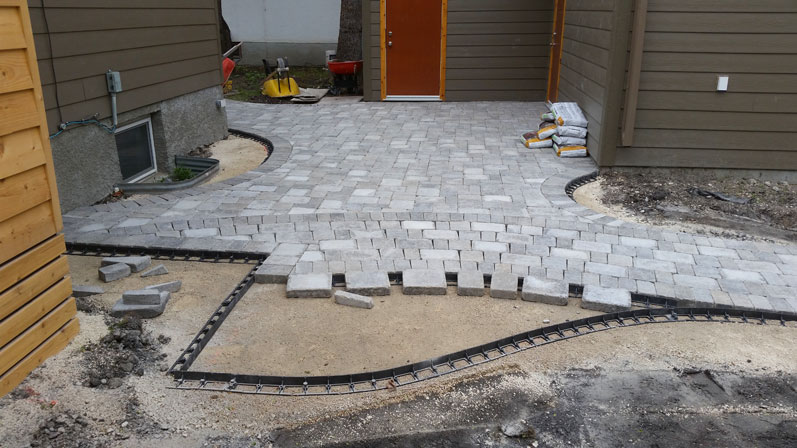Build It Yourself: A Guide to Paver Patio Construction

Having spent some time working on the design of your patio, is there any reason you can't also build it yourself? Funds may be a little tight, or you may be looking for a challenging summer project. A successful patio project doesn't require an engineering degree, but it will present some significant technical and physical challenges, which I'll go over in this article. A strong and durable patio is so much more than just some nice looking bricks. It is a system, with several components that work together to support loads, eliminate moisture, and accommodate soil movement.
Here is our step-by-step guide to building a long-lasting patio. The process can be divided into five phases:
- Excavation
- Base Prep
- Final leveling
- Paver installation
- Joint sand, final compaction and cleanup
Excavation
After drawing out the shape of your patio on the ground – we like to use orange marking paint – you need to excavate the entire area to a depth of 8" or more below the finished grade.
Make the excavation 8" to 12" wider than the actual patio size. This ensures that the pavers along the edge of the patio are well supported and that you have a solid place to attach your edge restraints at the end of the project.
There's actually a lot of material that gets removed. For a small 10' by 12' patio, for example, you'll be removing about 4 to 5 tons of dirt and clay. 6 or 8 trips with a pickup truck to your dumping spot will take care of this.
The bottom of the excavated area should have a 2% slope so that it sheds water. This is a 2- to 3-inch drop across the width of our small patio.
Base preparation
Your patio should be built on a 6" to 8" deep base of compacted 3/4" down limestone. Whatever material you removed during excavation will now be replaced by a similar weight of crushed stone.
Before you start hauling base stone, make sure the bottom of the excavated area is well compacted and cover the entire area with heavy grade geo-textile.
Geo-textile is similar to weed barrier fabric but heavier weight. In this application the purpose is not to stop weeds from growing up through the patio, but rather to separate the clay sub-soil from the crushed stone patio base, increasing its strength and extending the lifetime of your patio.
The stone base serves two main purposes. First, it increases the weight-bearing capacity of the native soil. Secondly, it allows water to drain away from the paver surface. Base compaction is critical to the success of your patio. Don't be tempted to save some money and use a hand tamper for this. It would be a brutal, exhausting job. A vibratory plate compactor is needed in order to fully compact the base and avoid uneven settling in the future. Spread the base stone in 3" lifts and compact it until the compactor starts to bounce like it is on concrete. You want the base to be literally as hard as concrete.
Final leveling
Once the base is in place and properly compacted, you need to refine the surface grading. Maintaining the 1-in-50 slope (2%) that you established during the excavation phase, use a screed board to spread more crushed stone. Alternate screeding and compacting, you will slowly fill in minor low spots.
For a screed board you can use a long, straight 2x4 or maybe the longest level you have hanging in your shop. 6 feet is the shortest useful length for this. We generally use screed boards 8' to 12' in length.
It is at this point, when you are so close to laying bricks that it is tempting to say "good enough". Please don't! Spend more time than you think you need to on final leveling. You want your base to be a perfectly even slope with no high spots or low spots.
Finally, we get to lay some bricks!
With the prep work complete you are now ready for the fun part of the job. Find the longest straight edge of your patio. This will be your starting place. If your patio is all curves, stretch a string line across the center of the patio and start there. Establish your pattern and work your way to the edges. As you place the bricks, take care not to slide them across the patio base. Rather, push each brick tight to its neighbours before pushing it down onto the base.
After days or weeks of prep work, this part goes by way too fast. The work will proceed quickly until you reach the edge of the patio.
You will have to cut some bricks to finish off the edge. If your patio is square or rectangular, there will be few cuts, but if curves are part of the plan you with have to do a lot more cuts. For this, you can rent an inexpensive brick splitter, or even shape the bricks with a hammer and brick chisel, but you will get cleaner, more precise results with an electric or gas powered concrete saw. These are fast and efficient, but the major drawback is the amount of dust they produce. Be sure to wear a face mask or a respirator. Once the edge bricks are cut, you can install the soldier course, followed by edge restraints.
Final details
With all the pavers cut and placed and everything locked into place with edge restraints, you must compact the pavers to level them and set them into the stone base. Compact the entire surface twice to make sure nothing is missed, then examine your patio looking for broken bricks. It is not uncommon to find bricks that have cracked under the force of the plate compactor. Replace these then compact everything one more time.
Next, fill the joints with sand, preferably polymeric joint sand. Spread the sand across the patio with a stiff broom. Alternate sweeping and compacting to ensure the sand completely fills the joints. At this point, follow the instructions on the bags of poly-sand. Different brands work best with slightly different methods, but essentially what you do is sweep off excess sand, blow the surface clean with a leaf blower (being careful not to blast the sand out of the joints, of course!), then shower the patio with water to activate the polymer adhesives and set the sand in the joints.
Voila! You have a patio! Clean up your tools, return the rental equipment, give the patio a little time to dry, and you are ready for your first patio party.
If you just have other things to do with your weekends this summer, send us an email at dwayne@earthworkslandscaping.ca. We'd love to meet with you and give you a quote.



